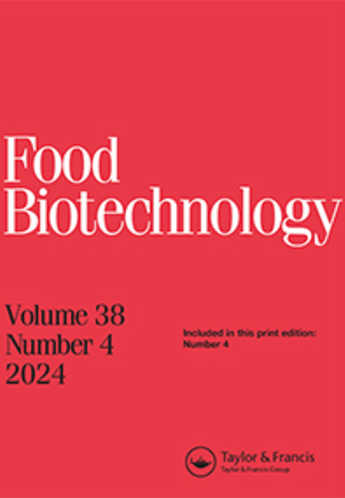Anti-inflammatory, anti-lipogenesis, and anti-obesity benefits of fermented Aronia vinegar evaluated in 3T3-L1 cells and high-fat diet induced C57BL/6 mice
IF 1.6
4区 农林科学
Q4 BIOTECHNOLOGY & APPLIED MICROBIOLOGY
引用次数: 0
Abstract
ABSTRACT This study evaluated the bioactivity and anti-obesity effects of Aronia vinegar (AV) prepared using Acetobacter pasterurianus SRCM 101341. AV had higher ABTS and DPPH radical scavenging activity (92.16 and 93.80%) compared with commercial vinegar (CV). Total polyphenol, flavonoid, and anthocyanin contents in the AV were 15.06 mg GAE/mL, 2.85 mg QE/mL, and 7.59 mg C3GE/L, respectively. RAW 264.7 cells treated with 3% AV showed higher inhibitory effect on nitric oxide production (21.6%) compared to CV treated cells. Similarly, 3T3-L1 cells treated with 3% AV showed decreased lipid (12.1%) and triglyceride (10.1%) accumulation compared to CV treated cells. Furthermore, qRT-PCR studies showed that 3% AV treatment suppressed 0.62- and 0.67-fold expression of PPAR-γ and C/EBPα in 3T3-L1 cells. Additionally, oral administration of AV reduced body weight, fat, and serum lipid profile without any histopathological effect in 5-week-old C57BL/6 obesity-induced mice.在3T3-L1细胞和高脂饮食诱导的C57BL/6小鼠中,研究了发酵苦苋菜醋的抗炎、抗脂肪生成和抗肥胖作用
摘要本研究考察了利用巴斯德脲醋酸杆菌SRCM 101341制备的野樱草醋的生物活性和抗肥胖作用。AV对ABTS和DPPH自由基的清除能力分别为92.16%和93.80%。总多酚、类黄酮和花青素含量分别为15.06 mg GAE/mL、2.85 mg QE/mL和7.59 mg C3GE/L。与CV处理的细胞相比,3% AV处理的RAW 264.7细胞对一氧化氮产生的抑制作用更高(21.6%)。同样,与CV处理的细胞相比,3% AV处理的3T3-L1细胞显示脂质(12.1%)和甘油三酯(10.1%)积累减少。此外,qRT-PCR研究显示,3% AV处理可抑制3T3-L1细胞中PPAR-γ和C/EBPα的0.62倍和0.67倍表达。此外,口服AV可降低5周龄C57BL/6肥胖小鼠的体重、脂肪和血脂水平,但无任何组织病理学影响。
本文章由计算机程序翻译,如有差异,请以英文原文为准。
求助全文
约1分钟内获得全文
求助全文
来源期刊

Food Biotechnology
工程技术-生物工程与应用微生物
CiteScore
3.80
自引率
0.00%
发文量
15
审稿时长
>12 weeks
期刊介绍:
Food Biotechnology is an international, peer-reviewed journal that is focused on current and emerging developments and applications of modern genetics, enzymatic, metabolic and systems-based biochemical processes in food and food-related biological systems. The goal is to help produce and improve foods, food ingredients, and functional foods at the processing stage and beyond agricultural production.
Other areas of strong interest are microbial and fermentation-based metabolic processing to improve foods, food microbiomes for health, metabolic basis for food ingredients with health benefits, molecular and metabolic approaches to functional foods, and biochemical processes for food waste remediation. In addition, articles addressing the topics of modern molecular, metabolic and biochemical approaches to improving food safety and quality are also published.
Researchers in agriculture, food science and nutrition, including food and biotechnology consultants around the world will benefit from the research published in Food Biotechnology. The published research and reviews can be utilized to further educational and research programs and may also be applied to food quality and value added processing challenges, which are continuously evolving and expanding based upon the peer reviewed research conducted and published in the journal.
 求助内容:
求助内容: 应助结果提醒方式:
应助结果提醒方式:


